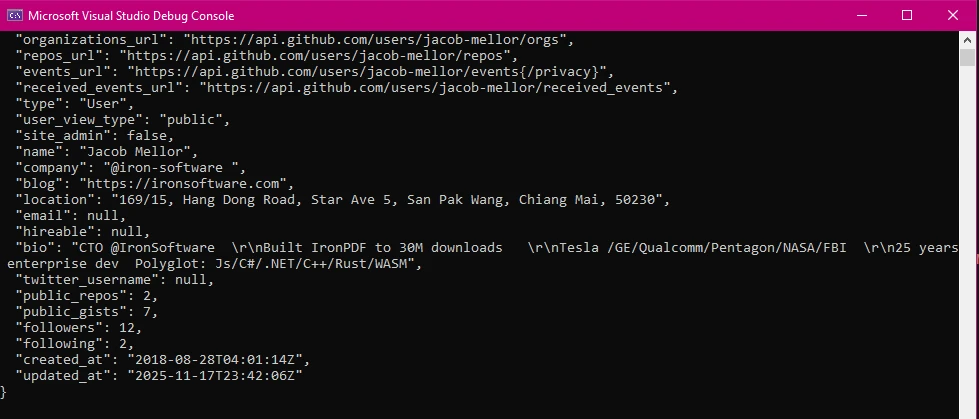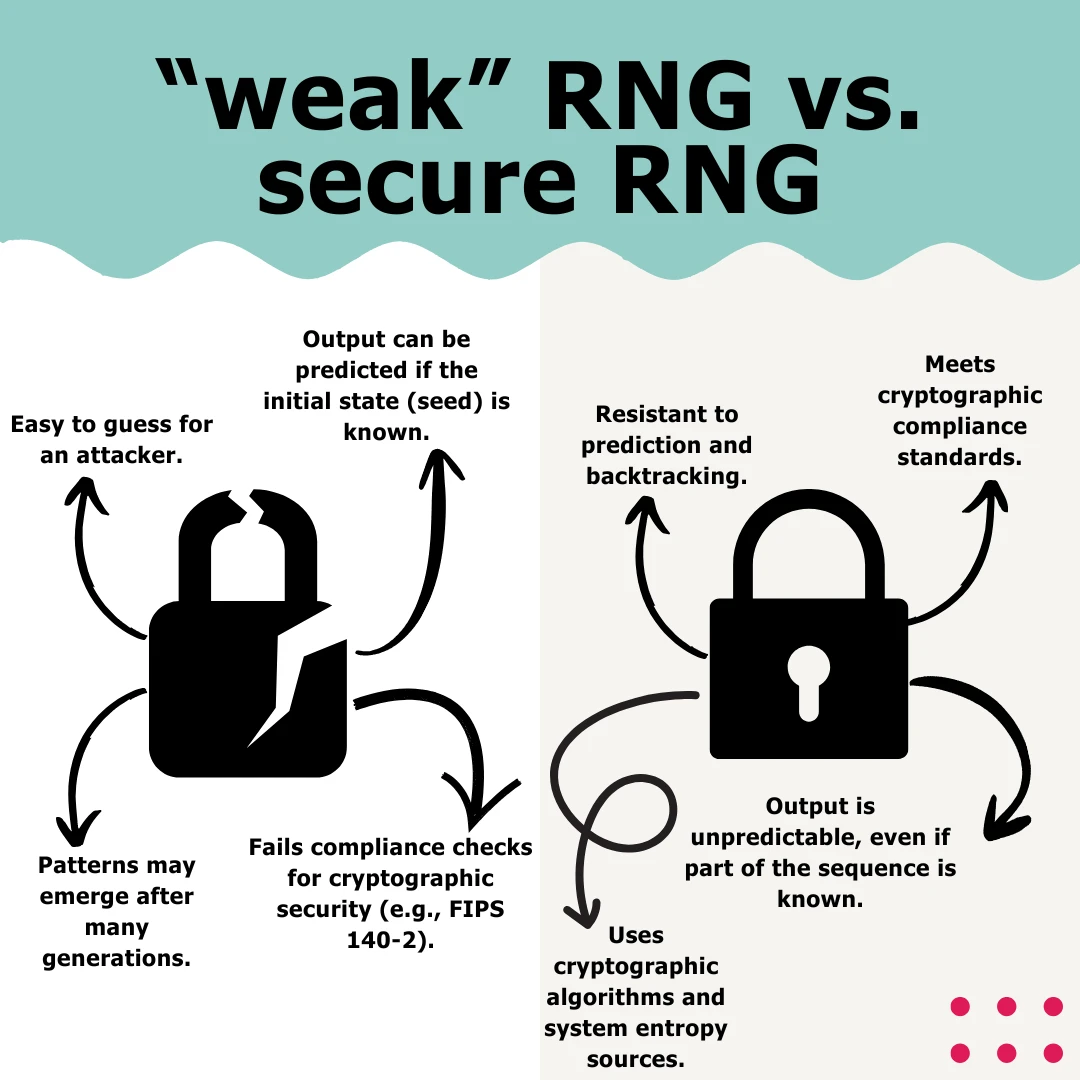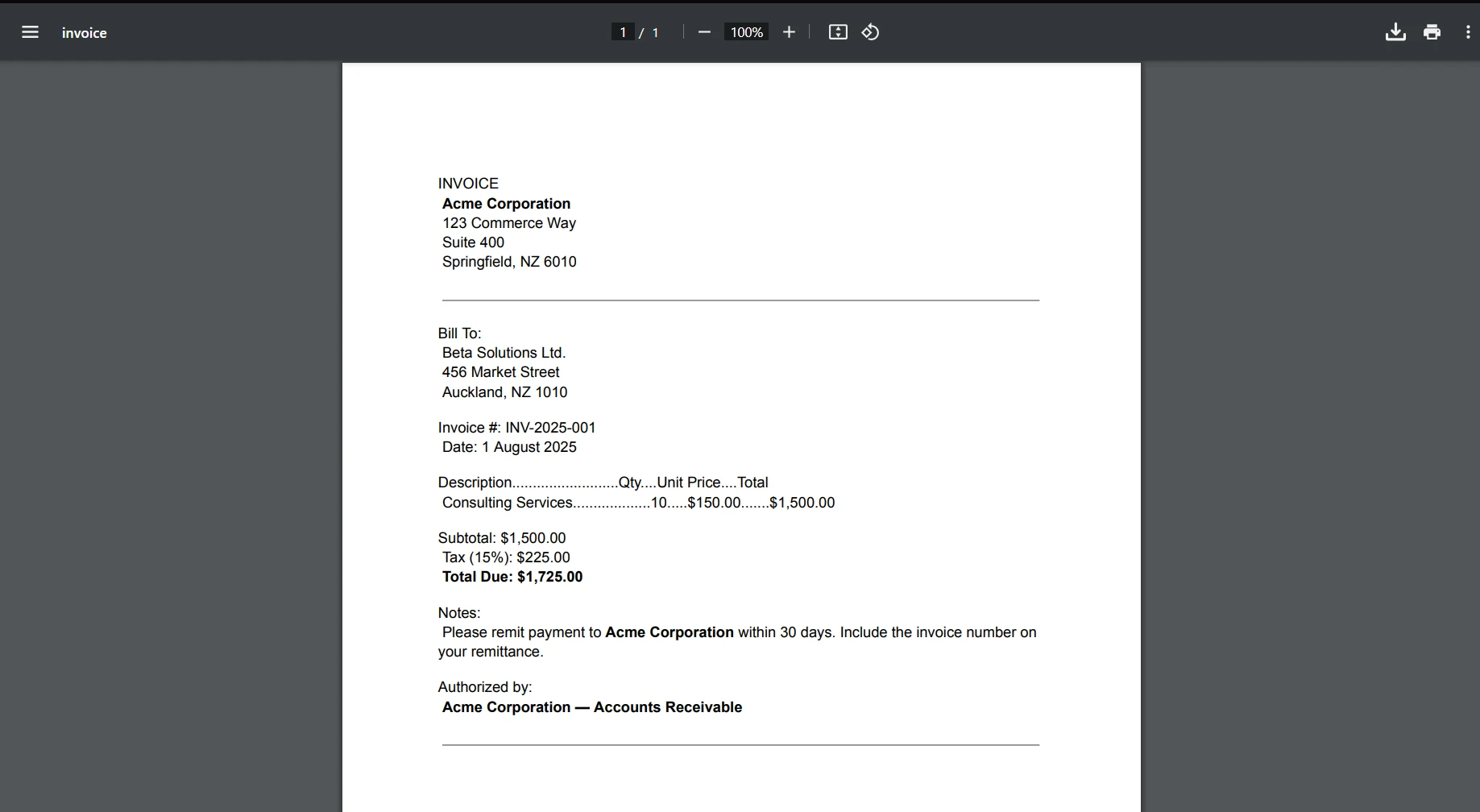LazyCache C# (How It Works For Developers)
Caching is a fundamental technique in software development for improving performance by storing frequently accessed data in memory or a faster storage medium. In C#, LazyCache is a popular library that simplifies thread-safe cache implementation, making it easier for developers to leverage caching effectively in their applications for heavy load scenarios.
What is LazyCache?
LazyCache is an underlying caching provider library for .NET/ ASP.NET Core applications that provides a simple and intuitive API for caching data. It is available as a NuGet package and can be easily integrated into C# projects. The primary goal of LazyCache is to simplify caching implementation and reduce the boilerplate code required to manage cached information using a double locking cache pattern.
Key Features of LazyCache:
Simple API: LazyCache provides a straightforward API for adding, retrieving, and removing cached items. Developers can quickly integrate caching into their applications or web service calls without dealing with complex caching mechanisms.
Automatic Expiration: LazyCache supports the automatic expiration of cached items based on configurable expiration policies. Developers can specify the expiration duration for cached items, and LazyCache removes expired items from the cache data.
In-Memory Caching: LazyCache stores cached items in memory by default, making it suitable for scenarios where fast access to cached data is required. In-memory caching ensures low latency and high throughput for cached data access.
Thread-Safe Operations: LazyCache provides thread-safe operations for adding, retrieving, and removing cached items. This ensures that multiple threads can access the cache concurrently without the risk of data corruption or inconsistency.
- Extensibility: LazyCache is designed to be extensible, allowing developers to customize caching behavior according to their specific requirements. It provides hooks for implementing custom caching strategies, such as distributed caching or caching with persistence.
How to Use LazyCache in C#:
Using LazyCache in C# is straightforward, thanks to its intuitive API. Below is a basic example demonstrating how to use LazyCache to cache the result of a method call:
using LazyCache;
public class DataService
{
// Define a private readonly field for the cache
private readonly IAppCache _cache;
// Constructor to initialize the cache
public DataService(IAppCache cache)
{
_cache = cache;
}
// Method to retrieve data (cached or fetched)
public string GetData()
{
return _cache.GetOrAdd("dataKey", () =>
{
// Simulate expensive operation such as database calls
return FetchDataFromDatabase();
});
}
// Simulate fetching data from a database
private string FetchDataFromDatabase()
{
return "Cached Data";
}
}using LazyCache;
public class DataService
{
// Define a private readonly field for the cache
private readonly IAppCache _cache;
// Constructor to initialize the cache
public DataService(IAppCache cache)
{
_cache = cache;
}
// Method to retrieve data (cached or fetched)
public string GetData()
{
return _cache.GetOrAdd("dataKey", () =>
{
// Simulate expensive operation such as database calls
return FetchDataFromDatabase();
});
}
// Simulate fetching data from a database
private string FetchDataFromDatabase()
{
return "Cached Data";
}
}Imports LazyCache
Public Class DataService
' Define a private readonly field for the cache
Private ReadOnly _cache As IAppCache
' Constructor to initialize the cache
Public Sub New(ByVal cache As IAppCache)
_cache = cache
End Sub
' Method to retrieve data (cached or fetched)
Public Function GetData() As String
Return _cache.GetOrAdd("dataKey", Function()
' Simulate expensive operation such as database calls
Return FetchDataFromDatabase()
End Function)
End Function
' Simulate fetching data from a database
Private Function FetchDataFromDatabase() As String
Return "Cached Data"
End Function
End ClassIn this example, the DataService class uses LazyCache to cache the result of the GetData() method. The GetOrAdd() method retrieves the cached data associated with the specified key ("dataKey") if it exists. If the data is not cached, the provided delegate FetchDataFromDatabase() is executed to fetch the data, which is then cached for future use.
Introduction to IronPDF
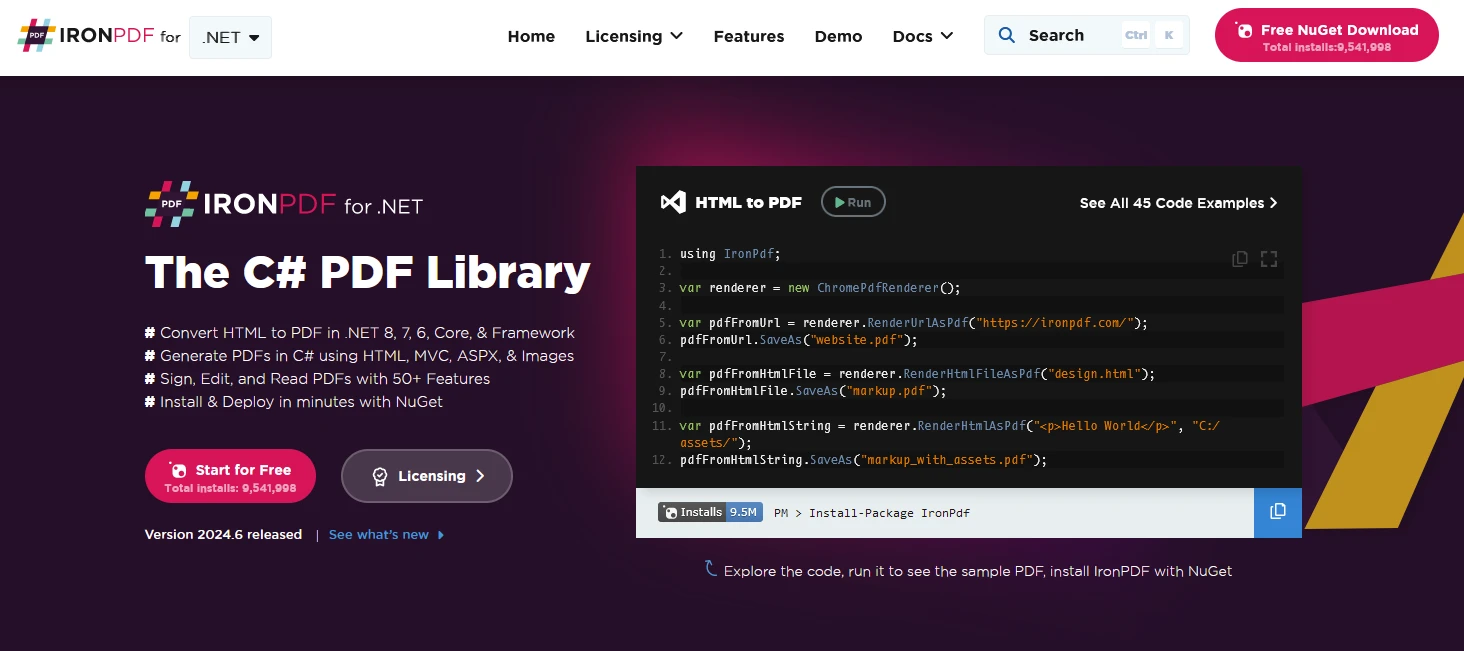
IronPDF is a powerful C# PDF library that allows generating, editing, and extracting content from PDF documents in .NET projects. Here are some key features:
HTML to PDF Conversion:
- Convert HTML, CSS, and JavaScript content to PDF format.
- Use the Chrome Rendering Engine for pixel-perfect PDFs.
- Generate PDFs from URLs, HTML files, or HTML strings.
Image and Content Conversion:
- Convert images to and from PDF.
- Extract text and images from existing PDFs.
- Support for various image formats.
Editing and Manipulation:
- Set properties, security, and permissions for PDFs.
- Add digital signatures.
- Edit metadata and revision history.
Cross-Platform Support:
- Works with .NET Core (8, 7, 6, 5, and 3.1+), .NET Standard (2.0+), and .NET Framework (4.6.2+).
- Compatible with Windows, Linux, and macOS.
- Available on NuGet for easy installation.
Generate PDF Document Using IronPDF And LazyCache
To start with, create a Console application using Visual Studio as below.
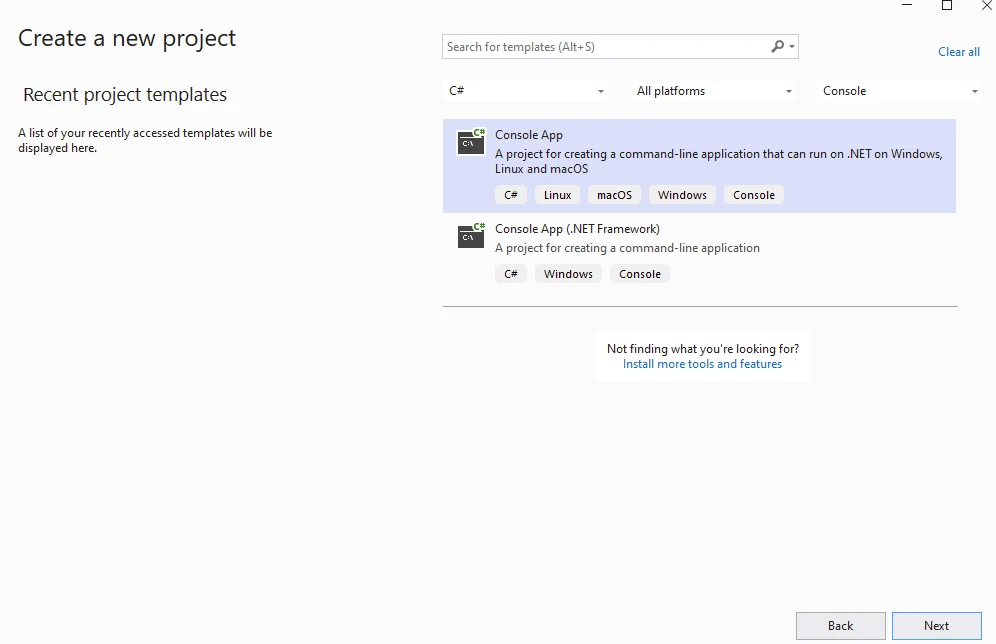
Provide Project Name.
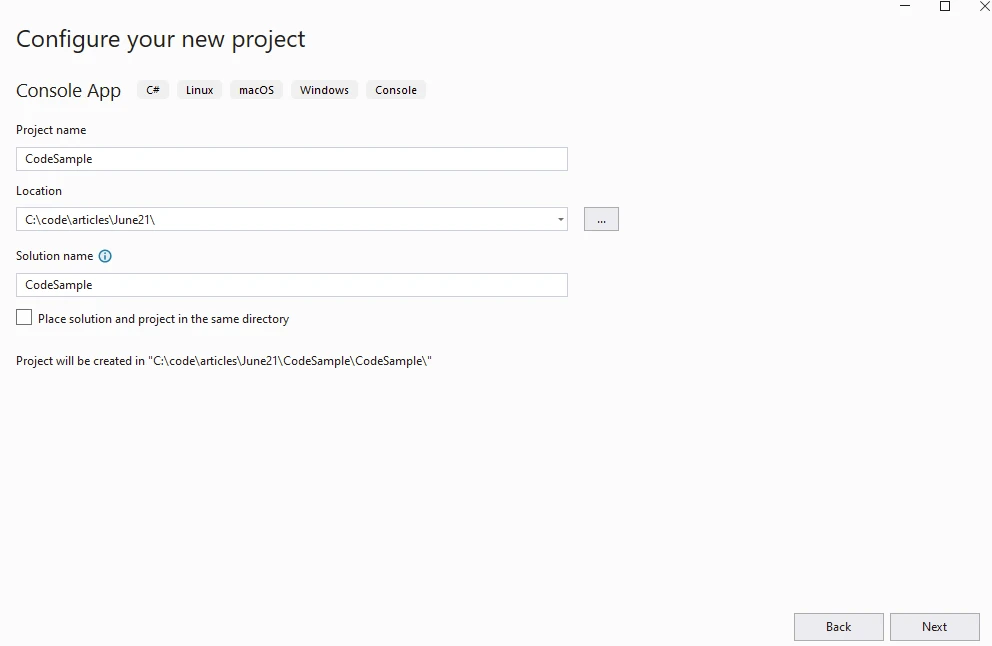
Provide .NET version.
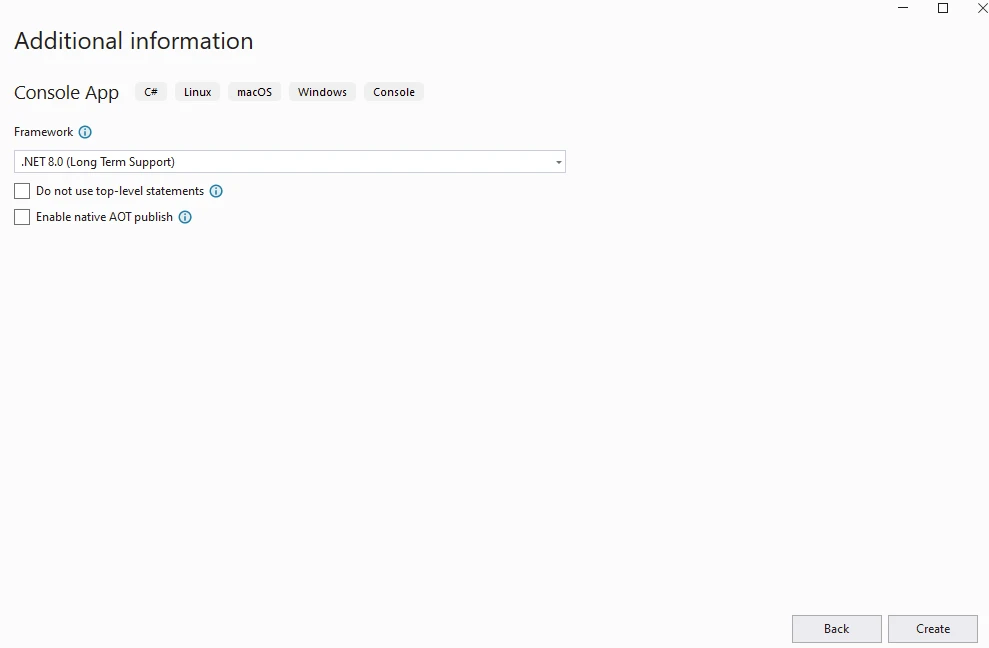
Install IronPDF package.
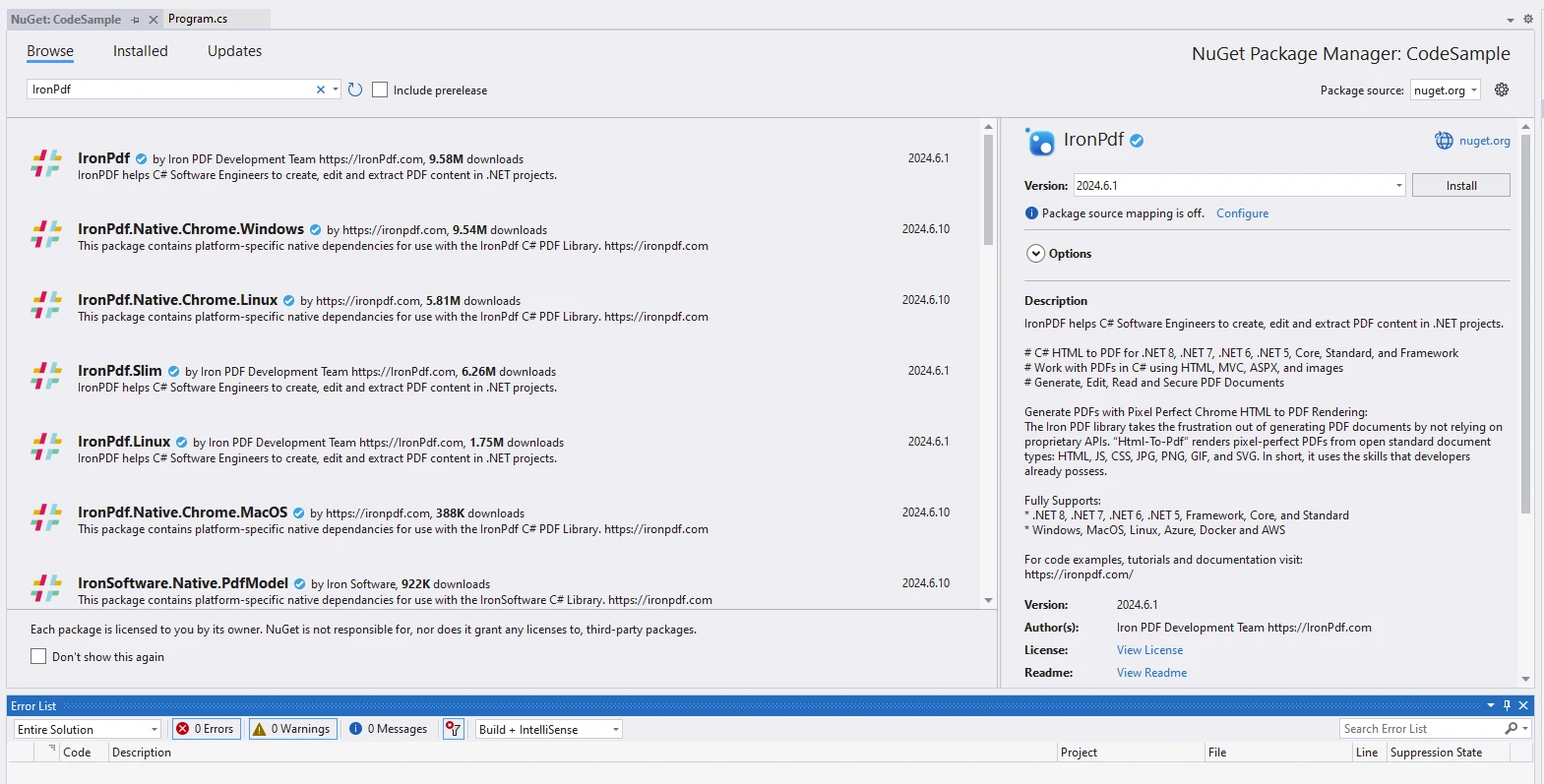
Install LazyCache package to add cached method calls.
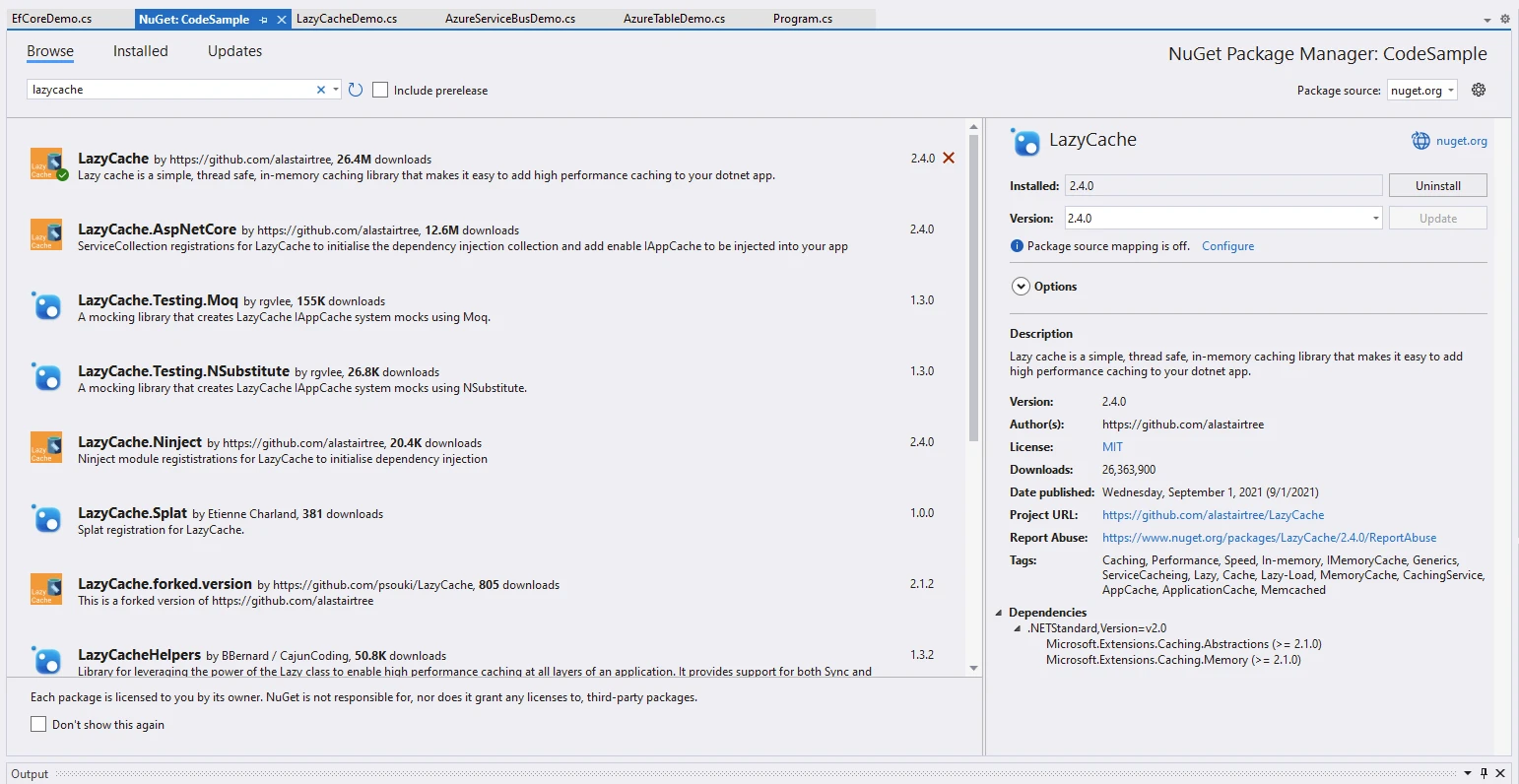
using LazyCache;
using IronPdf; // Add the IronPdf namespace
using System;
namespace CodeSample
{
internal class LazyCacheDemo
{
public static void Execute()
{
// Instantiate the Chrome PDF Renderer
var renderer = new ChromePdfRenderer();
var content = "<h1>Demo LazyCache and IronPDF</h1>";
content += "<h2>Create CachingService</h2>";
// Create the cache service using LazyCache
IAppCache cache = new CachingService();
var cacheKey = "uniqueKey"; // Unique key for caching the content
// Define a factory method to generate the cacheable data
Func<string> expensiveLongRunMethod = () =>
{
// Render the HTML content to a PDF
var pdf = renderer.RenderHtmlAsPdf(content);
// Export the rendered PDF to a file
pdf.SaveAs("AwesomeLazyCacheAndIronPdf.pdf");
// Return the content as a string
return content;
};
// Get the cached value or execute expensiveLongRunMethod to cache it
string cachedValue = cache.GetOrAdd(cacheKey, expensiveLongRunMethod);
// Output the cached value to the console
Console.WriteLine(cachedValue);
}
}
}using LazyCache;
using IronPdf; // Add the IronPdf namespace
using System;
namespace CodeSample
{
internal class LazyCacheDemo
{
public static void Execute()
{
// Instantiate the Chrome PDF Renderer
var renderer = new ChromePdfRenderer();
var content = "<h1>Demo LazyCache and IronPDF</h1>";
content += "<h2>Create CachingService</h2>";
// Create the cache service using LazyCache
IAppCache cache = new CachingService();
var cacheKey = "uniqueKey"; // Unique key for caching the content
// Define a factory method to generate the cacheable data
Func<string> expensiveLongRunMethod = () =>
{
// Render the HTML content to a PDF
var pdf = renderer.RenderHtmlAsPdf(content);
// Export the rendered PDF to a file
pdf.SaveAs("AwesomeLazyCacheAndIronPdf.pdf");
// Return the content as a string
return content;
};
// Get the cached value or execute expensiveLongRunMethod to cache it
string cachedValue = cache.GetOrAdd(cacheKey, expensiveLongRunMethod);
// Output the cached value to the console
Console.WriteLine(cachedValue);
}
}
}Imports LazyCache
Imports IronPdf ' Add the IronPdf namespace
Imports System
Namespace CodeSample
Friend Class LazyCacheDemo
Public Shared Sub Execute()
' Instantiate the Chrome PDF Renderer
Dim renderer = New ChromePdfRenderer()
Dim content = "<h1>Demo LazyCache and IronPDF</h1>"
content &= "<h2>Create CachingService</h2>"
' Create the cache service using LazyCache
Dim cache As IAppCache = New CachingService()
Dim cacheKey = "uniqueKey" ' Unique key for caching the content
' Define a factory method to generate the cacheable data
Dim expensiveLongRunMethod As Func(Of String) = Function()
' Render the HTML content to a PDF
Dim pdf = renderer.RenderHtmlAsPdf(content)
' Export the rendered PDF to a file
pdf.SaveAs("AwesomeLazyCacheAndIronPdf.pdf")
' Return the content as a string
Return content
End Function
' Get the cached value or execute expensiveLongRunMethod to cache it
Dim cachedValue As String = cache.GetOrAdd(cacheKey, expensiveLongRunMethod)
' Output the cached value to the console
Console.WriteLine(cachedValue)
End Sub
End Class
End NamespaceCode Explanation
Instantiate Renderer: An instance of
ChromePdfRendereris created to handle the conversion of HTML content into PDF format.Define Content: HTML content ("
Demo LazyCache and IronPDF
", "Create CachingService
", etc.) is prepared. This content will be rendered into a PDF and cached for reuse.Create Cache Service: A caching service (
IAppCache) is instantiated using LazyCache'sCachingService. This lazy cache service manages the storage and retrieval of cached data.Cache Key: A unique identifier ("uniqueKey") is assigned to represent the cached PDF content.
Define Expensive Method: A factory method (
expensiveLongRunMethod) is defined to generate the cacheable data. This method invokes theChromePdfRendererto render HTML content as a PDF. The resulting PDF is then saved and returned as a string.Get or Add to Cache: The
GetOrAddmethod of the service is called to retrieve the cached value associated with thecacheKey. If the value doesn't exist in the cache,expensiveLongRunMethodis invoked to compute it, store it in the cache, and return it. If the value is already cached, it's returned directly.- Output: The cached PDF content (as a string) is printed to the console (
Console.WriteLine(cachedValue)), demonstrating the retrieval of cached data.
Output

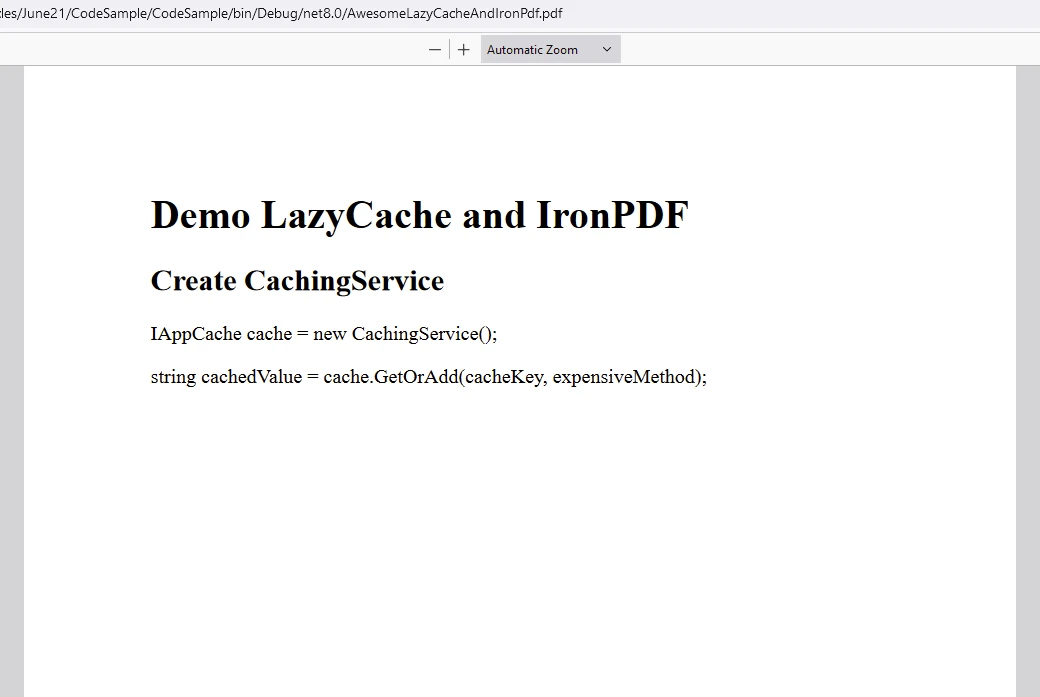
IronPDF Licensing (Trial Available)
IronPDF package requires a license to run and generate the PDF. Add the following code at the start of the application before the package is accessed.
IronPdf.License.LicenseKey = "IRONPDF-MYLICENSE-KEY";IronPdf.License.LicenseKey = "IRONPDF-MYLICENSE-KEY";IRON VB CONVERTER ERROR developers@ironsoftware.comA trial license is available on IronPDF's trial license page.
Conclusion
LazyCache simplifies caching implementation in C# applications by providing a straightforward API and automatic expiration of cached items. By integrating LazyCache into your projects, you can improve performance by efficiently caching frequently accessed data, reducing latency, and optimizing resource utilization in an atomic and tidy way. Whether you're building web applications, APIs, or services, LazyCache can be a valuable tool for enhancing the performance and scalability of your C# applications.
On the other hand, IronPDF stands out as a powerful and versatile C# library for handling PDF documents within .NET applications. Its robust capabilities encompass creating, editing, rendering HTML to PDF, and manipulating PDFs programmatically. With features for secure document handling through encryption and digital signatures, IronPDF empowers developers to efficiently manage and customize PDF workflows, making it a valuable tool for a wide range of document management and generation tasks in C# development.
Frequently Asked Questions
What is LazyCache and how does it benefit .NET applications?
LazyCache is a caching provider library designed for .NET/ASP.NET Core applications. It benefits these applications by simplifying the implementation of caching, reducing boilerplate code, and enhancing performance through in-memory data storage, which minimizes unnecessary data retrieval operations.
How can you implement caching in C# using LazyCache?
To implement caching in C# using LazyCache, you need to install the library via NuGet and set up a caching service using LazyCache's CachingService. You can cache data by using the GetOrAdd method, which stores the result of method calls and provides a unique key and delegate to fetch data if it's not already cached.
How does LazyCache ensure the data remains current in cache?
LazyCache ensures data remains current by supporting automatic expiration of cached items based on configurable policies. This feature allows developers to set expiration times, ensuring that outdated data is not served to users.
What makes LazyCache thread-safe?
LazyCache is thread-safe due to its design, which allows multiple threads to interact with the cache without risking data corruption. It uses a double-locking mechanism to ensure that cache operations are performed safely in multithreaded applications.
How can you optimize PDF document management in C# projects?
You can optimize PDF document management in C# projects using IronPDF, which provides robust capabilities such as HTML to PDF conversion, content extraction, and PDF editing. It supports cross-platform compatibility and can be integrated with LazyCache to cache generated PDFs for improved performance.
Is it possible to use LazyCache for distributed caching?
Yes, LazyCache offers extensibility that allows developers to implement custom caching strategies, including distributed caching. This flexibility enables integration with other caching systems to support distributed environments.
What are the advantages of using a C# PDF library alongside LazyCache?
Using a C# PDF library like IronPDF alongside LazyCache allows you to generate and cache PDF documents efficiently. This combination improves application performance by avoiding redundant PDF generation and provides quick access to frequently requested documents.
What are the licensing requirements for using a C# PDF library like IronPDF?
IronPDF requires a license to utilize its full functionality. Developers can start with a trial license available on IronPDF's website and must include the license key in their application code to activate the library for generating PDFs.
How does LazyCache improve application performance?
LazyCache improves application performance by storing frequently accessed data in memory, reducing the need for repeated data retrieval operations. This results in faster response times and reduced load on databases or external data sources.


